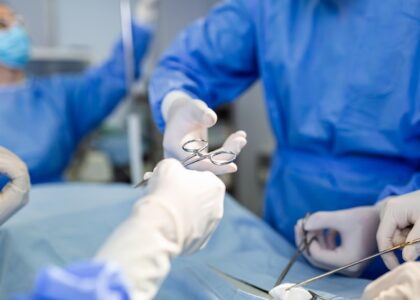Hernia is defined as a defect or weakening in the muscular or fascial layer of the abdomen, through which abdominal visceral contents like bowel loops or omental fat can protrude out.
Hernia occurs through naturally weakened areas of the abdomen (Inguinal canal and umbilical tube) or sites of previous surgery and trauma. Hernia can be congenital (present since birth) or acquired (develop in later age). Increased abdominal pressure is the main cause of acquired hernia formation. Factors which contribute to hernia are chronic cough, constipation, urinary symptoms, obesity and smoking.
Common sites of hernia formation are groin (Inguinal), belly button (Umbilical), upper abdomen (Epigastric) or site of previous operation (Incisional).
Hernia can present solely as a swelling (bulge) beneath the skin, which increases on coughing or straining, and decreases on lying down. Sometimes people may have dragging sensation, discomfort or pain at the site of bulge. Continuous pain, redness or tenderness over the swelling, associated with gastro-intestinal symptoms suggests complication of hernia, which warrants urgent surgical intervention.
Hernia never reverses of its own, but gradually keeps on increasing in size over time. No medicine can treat hernia, as it is a defect in the abdominal wall which need to be repaired surgically. Use of truss (Hernia belt) is usually ineffective, and only delays the definitive treatment. Hernia is considered a semi-emergency, requiring early surgery, as it can anytime lead to cascade of complications.
Hernia can be repaired by open technique or laparoscopically. Most of the hernias nowadays are repaired laparoscopically. Three to four small punctures are made, varying from 5 – 10 mm in size. Laparoscopic Surgery for Inguinal hernias is performed using TEP (Total Extra-peritoneal) or TAPP (Trans-abdominal Pre-Peritoneal) techniques. For Ventral / Incisional / Umbilical / Epigastric hernias, Laparoscopic Surgery is performed using IPOM (Intra-peritoneal onlay mesh), Hybrid or abdominal wall reconstruction techniques.
Mesh is usually indicated for most of the hernias to do a tension free repair of the hernia defect. Use of mesh decreases the recurrence rate of hernia. Non-absorbable polypropylene or partially absorbable meshes are used in inguinal hernia repair and abdominal wall reconstruction. Special composite meshes (prevents mesh complications in contact with abdominal viscera) with fixation devices are used in ventral hernia repair, which adds extra cost to laparoscopy surgery.
Laparoscopy Surgery is considered superior to open surgery because of following benefits: Early recovery after surgery, decreased pain, better cosmesis, minimal scar on the abdomen, early return to work, no residual weakness and better surgical precision.
Laparoscopy Surgery is considered safe for people suffering with other medical problems like Diabetes, Hypertension, Kidney disorder or Obesity. Minimization of the trauma to the body by Minimal Access Surgery (MAS) causes minimal disturbance of normal physiology. It can also be performed safely in children, procedure called herniotomy, for hernias in paediatric age group.



